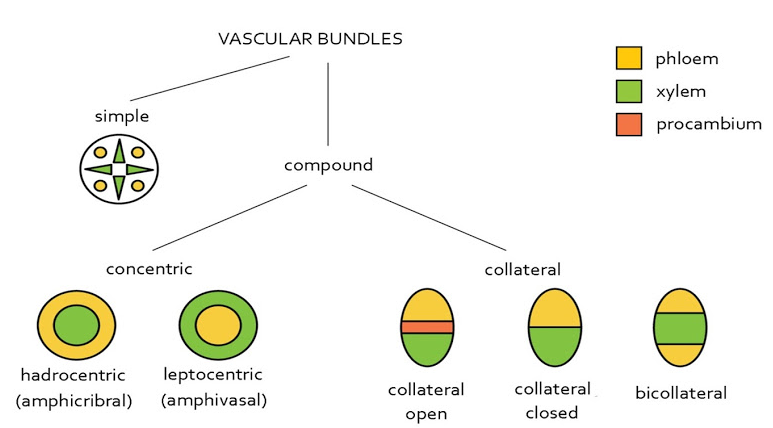Vascular tissue
The vascular system is composed of the conductive tissues xylem and phloem. A group of xylem and phloem forms the vascular bundle.
In dicots, cambium is present between the xylem and phloem. This allows the vascular bundle to form secondary xylem and phloem tissue. Such a vascular bundle is called an open vascular bundle.
In monocots, there is no cambium between xylem and phloem. Thus they cannot form secondary tissues, and are hence called closed vascular bundles.
Different types of Vascular bundles
Collateral Vascular bundles
When the xylem and phloem occur along the same radius, it is called a collateral bundle. It can be of different types, based on the arrangement of xylem and phloem, and the presence of cambium.


Various types of vascular bundles: (a) Radical (b) Conjoint Closed (c) Conjoint Open
- Collateral Open: Xylem is seen towards the inner side, and phloem is found towards the outer side. Cambium is present in between them. (e.g. Dicot stem)
- Collateral Closed: Xylem is seen towards the inner side, and phloem is found towards the outer side. But there is no cambium in between. (e.g. Monocot stem)
 Bi-collateral Vascular Bundle
Bi-collateral Vascular Bundle
- Bicollateral: There are two patches of phloem with a single patch of xylem in between them. Two patches of cambium are present. (e.g. Family Solanacea and Cucurbitaceae)
Concentric Bundles
In this type, one type of tissue surrounds the other.
- Amphicribral : Xylem is found at the centre, with phloem surrounding it.
- Amphivasal: A small patch of phloem is surrounded by xylem tissue.
Radial Bundles
The vascular tissues i.e. xylem and phloem, are separate, and are found in alternate pattern along different radii.


Radical Vascular Bundles
Ground Tissue System (Fundamental tissue system)
- All tissue except the epidermis and the vascular tissues constitute the ground tissue.
- It is composed of simple tissues such as parenchyma, collenchyma and sclerenchyma.
- It forms the major bulk of the plant body.
- The ground tissue is differentiated into various zones such as – Cortex, Endodermis, Pericycle, Pith and Medullary rays.
- The endodermal cells of root have bands of thickening due to the deposition of lignin and suberin. These bands are called casparian thickenings.
- The ground tissue in leaf is called mesophyll. In dicot leaf, the mesophyll is differentiated into palisade and spongy tissues. There is no such distinction in monocot leaves.